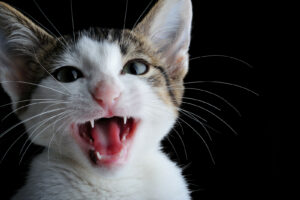Barks Blog
Keep Calm and Carry On De-stressing
This article discusses how feline behavior consultants can help cats diagnosed with Feline Idiopathic Cystitis

By Andrea Carne
Feline Idiopathic Cystitis – or FIC for short – is a complex name for an intriguing disease, but cat behavior consultants need to be well versed in all that it encompasses, and here’s why:
FIC accounts for around two thirds of all cases of feline lower urinary tract disease (FLUTD) (International Cat Care, 2018).
One of the first symptoms of FLUTD (and therefore FIC) is changes in toileting behavior. And what’s the number one behavioral issue cat guardians seek help with? Inappropriate toileting!
Now, while inappropriate toileting can happen for many reasons, the first thing any cat behavior consultant should recommend to a client with this issue is a comprehensive veterinary visit to check for underlying health issues.
Inappropriate Toileting Behavior
If a client describes any of the following behavior in relation to the inappropriate toileting, then the vet visit is even more critical:
- Difficulty or painful urination – crying out when using the tray or not excreting much urine each time; or straining to urinate with nothing coming out (more common in male cats and should always be treated as an emergency if noted);
- Increased frequency of urination – making several more trips to the tray than usual;
- Blood in urine;
- Urinating outside of the litter tray;
- Overgrooming – especially around the ‘private parts’; and
- Reluctance to engage with owners or be touched – hiding more, feigning sleep etc. – where this is out of character for the cat.
Diagnostic Tests
A vet will likely run a series of diagnostic tests including urinalysis, bloodwork and perhaps even x-rays and/or ultrasound of the bladder.
If these tests rule out things like bacterial infections or more sinister things like tumors or disease of some kind, then a guarded diagnosis of FIC may be made. I say ‘guarded’ because the problem with FIC is that (a) there is currently no diagnostic test that will give a definitive diagnosis of FIC and (b) the condition has no obvious underlying cause, like infection for example.
It’s basically a process of elimination – once all other forms of FLUTD are ruled out, FIC is a definite possibility. It can therefore also be difficult to manage and, unfortunately, it can come and go for varying periods of time throughout the cat’s life.
“In cats with FIC, analysis of a urine sample may show the presence of blood and inflammatory cells, but there is no recognizable underlying cause (e.g., bladder stones or infection) to explain these changes. It is common to also find microscopic evidence of crystals in urine samples … However, these crystals are not the cause of the cystitis (bladder inflammation) and can be found in cats both with and without FIC as cats often produce very concentrated urine.” (International Cat Care, 2018).
Frequent Urination
So, here’s a common scenario: a cat guardian presents at a vet with a cat that is urinating more frequently, but perhaps only small amounts at a time. They are going back and forth to the litter trays with very little result each time.
Infection and other abnormalities are ruled out via testing and the cat is otherwise healthy. So, what now?
Well, while FIC is a disease of unknown cause, there are some abnormalities which appear to be common in cats with the condition. These include a defective bladder lining and neurogenic inflammation, but perhaps most important – in terms of things a cat guardian can help with – is that cats with FIC are commonly experiencing stress and having abnormal responses to that stress.
“…not only is there good evidence that stress plays a role in provoking FIC in affected cats, but there is also evidence that these cats do not handle stress in a ‘normal’ way. In healthy individuals, stress results in the release of two types of hormones from the adrenal glands (glands close to the kidneys). Stress normally induces the release of both ‘catecholamines’ (adrenaline and noradrenaline), and also cortisol. However, in cats with FIC, while catecholamine concentrations tend to be high (reflecting an underlying stress response) they actually have sub-normal cortisol responses and are thus not responding in a normal way.” (International Cat Care, 2018).
Cats and Stress
And this is where cat behavior consultants come into play. While the vet may prescribe some medication to assist (e.g. an anti-inflammatory or even antidepressants, depending on the case and its severity), and perhaps recommend a change in diet to promote urinary tract health, it is just as crucial – perhaps even more so – to work on a multimodal response which includes reducing the stress may have played a role in the appearance of FIC.
So, as with any other case of inappropriate toileting, a cat with FIC needs an environment that helps reduce stress …BUT they must also be encouraged to drink more and urinate more frequently (not hold on) in order to keep their urinary tract in tip-top health and reduce the likelihood of future incidences of FIC.
We, therefore, need to look at what may be causing stress in their environment and look at ways of increasing water intake and better toileting habits. Examples of stressors that may be at play here include:
- Poor location of litter trays;
- Insufficient numbers and cleanliness of litter trays;
- Inappropriate sizes of trays and types and amounts of litter used;
- Poor choice in drinking stations – locations, numbers, types;
- Conflict with another cat or cats in the home;
- Changes to the environment and/or routines (e.g. visitors, owner absence); and
- Lack of enrichment.
Environmental Management
So, with this in mind, there are many things cat guardians can be encouraged to do in order to help reduce the prevalence of FIC flare-ups. Here are some examples:
- Provide plenty of fresh water at all times via a variety of drinking stations in a number of locations throughout the home – water bowls should ideally be ceramic, wide and shallow, placed away from walls and well separated from feeding and toileting areas. Some cats prefer running water and this can be provided via a water fountain. Flavoring water with chicken or tuna may also help, as may adding water to food;
- Provide plenty of litter trays in quiet locations – one per cat plus one extra is ideal and more if needed. Ensure they are cleaned regularly. Ensure the trays are appropriate sizes so the cat has room to move around, does not have difficulty getting in or out, and that the litter is of a sufficient depth to allow them to have a good dig. Trying different types of litter may also be a good idea to find the cat’s preference;
- Provide more enrichment, not just through more litter trays and drinking stations as mentioned, but also via more places to hide, rest, perch and sleep; high places to escape to and feel a sense of comfort and control; playtime specific for the individual cat; scratching equipment; self-play toys; puzzle feeders and human interaction (by the cat’s choice);
- Ensure any conflict between cats is managed by increasing resources and enrichment to alleviate the need to compete and provide plenty of choice for each cat;
- Provide and maintain routine – cats like routine and this is particularly important for cats prone to stress. Any changes to routine can cause stress. Keep mealtime, playtime, grooming time etc. to a regular routine and minimize any alterations to this.
Older Cats
And one final note here, based on my own experiences with my beloved 20-year-old-cat. Cats may become more prone to stress and therefore FIC as they age.
My boy had his first bout of FIC not long ago, seemingly caused by us leaving him with a cat sitter for two nights. No issues in the past, but a sudden change in his routine and environment was all that it took. So, being mindful of additional needs for elderly cats is very important.
As cat behavior consultants, we are called upon to assist with all sorts of behavioral issues, but those associated with FIC are certainly some of the more interesting ones in terms of clearly showing a link between stress and physical health in felines.
However, in my experience, getting ‘back to basics’ is the key here: ensuring the affected cat has an enriched environment which is as low-stress as possible (including reducing tension among cats in a multi-cat household); good provision of toileting areas and drinking stations (and maintenance of same); and solid, predictable routines.
Provide these as a minimum and your client will be well on the way to helping prevent flare-ups of this complex condition.
References
Atkinson, T. (2018) Practical Feline Behaviour: Understanding Cat Behaviour and Improving Welfare. Oxfordshire, UK: CABI
International Cat Care. (2018). Feline Idiopathic Cystitis (FIC)

